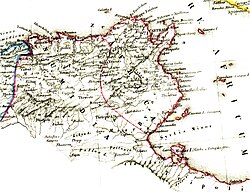Artabanes
Artabanes | |
|---|---|
| Allegiance | Casilinum |
| Relations | Arsaces |
Artabanes (
Early life
Artabanes was a descendant of the royal Armenian
Revolt against Byzantium
In 538/539, Artabanes, at the time apparently still a young man, took part in the Armenian conspiracy against
Service in Africa
At some time around 544, perhaps as early as 542, Artabanes, his brother John and several other Armenians deserted back to the Byzantines.[1]

Along with his brother, Artabanes was placed in command of a small Armenian contingent and sent to Africa in spring 545 under the senator Areobindus.[1] There, the Byzantines were engaged in a protracted war with the rebellious Moorish tribes. Shortly after their arrival, John died in battle at Sicca Veneria with the rebel forces of the renegade Stotzas.[4] Artabanes and his men remained loyal to Areobindus during the rebellion of the dux Numidiae Guntharic in late 545. Guntharic, allied with the Moorish chieftain Antalas, marched on Carthage and seized the city gates. At the urging of Artabanes and others, Areobindus decided to confront the rebel. The two armies appeared evenly matched, until Areobindus took fright and fled to a monastery seeking sanctuary. Thereupon the troops loyal to him also fled, and the city fell to Guntharic.[5]
Areobindus was murdered by Guntharic, but Artabanes secured guarantees of his safety and pledged himself to Guntharic's service. In secret, however, he began planning to overthrow him. Soon after, Artabanes was entrusted, alongside John and Ulitheus, with an expedition against Antalas's Moors. He marched south, along with an allied Moorish contingent under Cutzinas. Antalas's men fled before him, but Artabanes did not pursue them and turned back. According to Procopius, he considered leading his men to join the loyalist imperial garrison that held out at Hadrumetum under Marcentius, but decided to return to Carthage and go on with his plan to assassinate Guntharic.[6] Artabanes kept his plan in absolute secrecy for a long time, confiding only with his two closest Armenian friends: even his Armenian unit of hand-picked and completely loyal veteran soldiers was not aware of it until the very last moment. Such a perfect concealment was achieved, not least thanks to the fact that during both planning and implementation stages of this assassination the communication between the exclusively Armenian conspirators was in their mother tongue, an incomprehensible language for other ethnic elements of the imperial army in Africa.[7]
Upon his return to Carthage, he justified his decision to turn back by insisting that the entire army was needed to quell the insurgents, and urged Guntharic to set forth himself. At the same time, he conspired with his nephew, Gregory, and a few other of his Armenian bodyguards to murder the usurper (although Corippus suggests that it was the praetorian prefect Athanasius who was the real mastermind of the plot). On the eve of the army's departure in early May, Guntharic hosted a great banquet, and invited Artabanes and Athanasius to share the same couch, a mark of honour. Suddenly, during the banquet, Artabanes' Armenians fell upon Guntharic's bodyguards, while Artabanes himself allegedly landed the killing blow on Guntharic.[8]
This deed won him great honour and fame: Praejecta, the widow of Areobindus and niece of Justinian, whom Guntharic was planning to marry, gave him a rich reward, while the emperor confirmed him as magister militum of Africa. Despite being already married to a relative of his, Artabanes eventually became engaged with Praejecta. He sent her back to Constantinople and himself asked from Justinian to be recalled from Africa, so that they could marry.[9]
Artabanes at Constantinople and the conspiracy against Justinian

Soon afterwards, Artabanes was indeed recalled to Constantinople, replaced in Africa by
Irritated over this affair, shortly after Theodora's death (late 548/early 549) he became involved in the so-called "Armenian Plot" or "Conspiracy of Artabanes". The real instigator, however, was a relative of his, named
Service in Italy
In 550, Artabanes was appointed magister militum per
In 553, he crossed over into mainland Italy, where he joined the army of
References
- ^ a b c Martindale 1992, p. 125.
- ^ Martindale 1992, pp. 8–9, 125, 1162.
- ^ Martindale 1992, pp. 125, 255, 641.
- ^ Martindale 1992, pp. 108, 643.
- ^ Martindale 1992, pp. 108–109, 126, 575.
- ^ Martindale 1992, p. 126.
- ^ Ayvazyan 2012, p. 30.
- ^ Martindale 1992, pp. 126–127, 143, 576; Bury 1958, p. 146.
- ^ Martindale 1992, pp. 125, 127, 576, 1048; Bury 1958, p. 146.
- ^ Martindale 1992, pp. 127–128, 1048–1049; Bury 1958, p. 67.
- ^ Martindale 1992, p. 128; Bury 1958, pp. 66–67.
- ^ Bury 1958, pp. 67–68.
- ^ Martindale 1992, pp. 128–129; Bury 1958, p. 68.
- ^ Martindale 1992, p. 129; Bury 1958, pp. 69, 255–256.
- ^ Martindale 1992, p. 129; Bury 1958, p. 260.
- ^ Martindale 1992, pp. 129–130.
- ^ Martindale 1992, pp. 130, 789–790.
- ^ Martindale 1992, p. 130; Bury 1958, p. 279.
Sources
- Ayvazyan, Armen (2012). The Armenian Military in the Byzantine Empire: Conflict and Alliance under Justinian and Maurice. Alfortville: Sigest. ISBN 978-2-9173-2939-9. Archived from the originalon 2019-02-10. Retrieved 2014-10-19.
- ISBN 0-486-20399-9.
- ISBN 0-521-20160-8.
